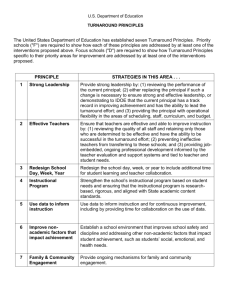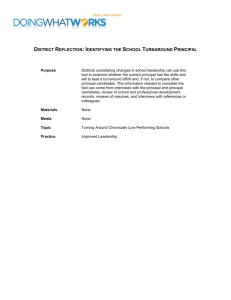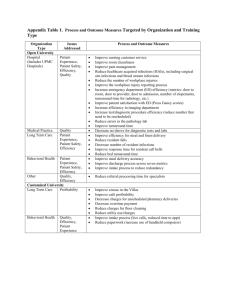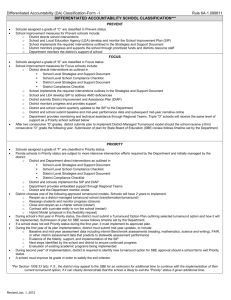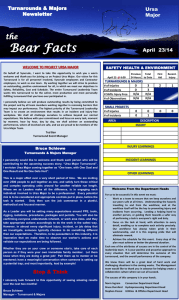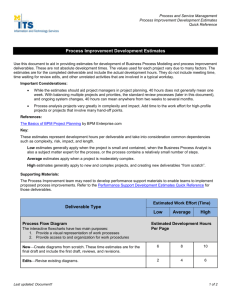organizational decline and turnaround
advertisement
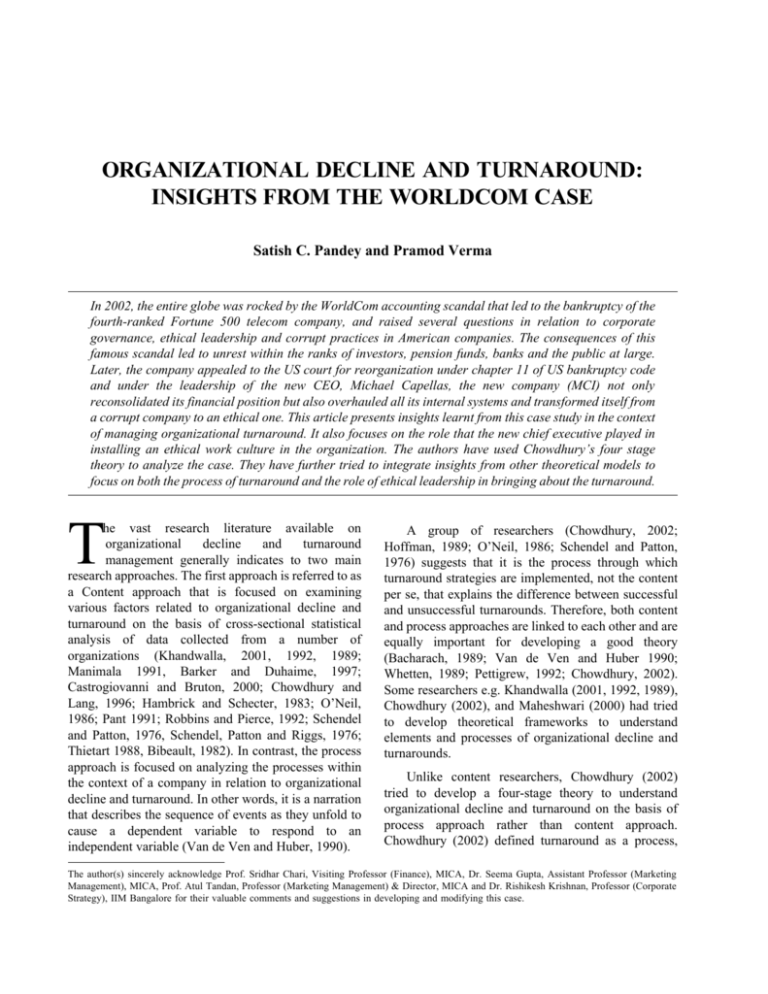
ORGANIZATIONAL DECLINE AND TURNAROUND: INSIGHTS FROM THE WORLDCOM CASE Satish C. Pandey and Pramod Verma In 2002, the entire globe was rocked by the WorldCom accounting scandal that led to the bankruptcy of the fourth-ranked Fortune 500 telecom company, and raised several questions in relation to corporate governance, ethical leadership and corrupt practices in American companies. The consequences of this famous scandal led to unrest within the ranks of investors, pension funds, banks and the public at large. Later, the company appealed to the US court for reorganization under chapter 11 of US bankruptcy code and under the leadership of the new CEO, Michael Capellas, the new company (MCI) not only reconsolidated its financial position but also overhauled all its internal systems and transformed itself from a corrupt company to an ethical one. This article presents insights learnt from this case study in the context of managing organizational turnaround. It also focuses on the role that the new chief executive played in installing an ethical work culture in the organization. The authors have used Chowdhury’s four stage theory to analyze the case. They have further tried to integrate insights from other theoretical models to focus on both the process of turnaround and the role of ethical leadership in bringing about the turnaround. T he vast research literature available on organizational decline and turnaround management generally indicates to two main research approaches. The first approach is referred to as a Content approach that is focused on examining various factors related to organizational decline and turnaround on the basis of cross-sectional statistical analysis of data collected from a number of organizations (Khandwalla, 2001, 1992, 1989; Manimala 1991, Barker and Duhaime, 1997; Castrogiovanni and Bruton, 2000; Chowdhury and Lang, 1996; Hambrick and Schecter, 1983; O’Neil, 1986; Pant 1991; Robbins and Pierce, 1992; Schendel and Patton, 1976, Schendel, Patton and Riggs, 1976; Thietart 1988, Bibeault, 1982). In contrast, the process approach is focused on analyzing the processes within the context of a company in relation to organizational decline and turnaround. In other words, it is a narration that describes the sequence of events as they unfold to cause a dependent variable to respond to an independent variable (Van de Ven and Huber, 1990). A group of researchers (Chowdhury, 2002; Hoffman, 1989; O’Neil, 1986; Schendel and Patton, 1976) suggests that it is the process through which turnaround strategies are implemented, not the content per se, that explains the difference between successful and unsuccessful turnarounds. Therefore, both content and process approaches are linked to each other and are equally important for developing a good theory (Bacharach, 1989; Van de Ven and Huber 1990; Whetten, 1989; Pettigrew, 1992; Chowdhury, 2002). Some researchers e.g. Khandwalla (2001, 1992, 1989), Chowdhury (2002), and Maheshwari (2000) had tried to develop theoretical frameworks to understand elements and processes of organizational decline and turnarounds. Unlike content researchers, Chowdhury (2002) tried to develop a four-stage theory to understand organizational decline and turnaround on the basis of process approach rather than content approach. Chowdhury (2002) defined turnaround as a process, The author(s) sincerely acknowledge Prof. Sridhar Chari, Visiting Professor (Finance), MICA, Dr. Seema Gupta, Assistant Professor (Marketing Management), MICA, Prof. Atul Tandan, Professor (Marketing Management) & Director, MICA and Dr. Rishikesh Krishnan, Professor (Corporate Strategy), IIM Bangalore for their valuable comments and suggestions in developing and modifying this case. 52 ● Pandey and Verma composed of a sequence of events that, when combined, describe the occurrence of performance improvement over a particular span of time. The four stages proposed by Chowdhury are: decline, response initiation, transition and outcome. This model is based on developmentalism, that is, although the external forces, such as competitive dynamics of immediate competitors and/or pressure from key stakeholders, greatly influence how the turnaround outcome unfolds; top management is able to control that influence to a large extent (Chowdhury, 2002). In this paper, we have tried to understand the process of organizational decline and turnaround in the context of WorldCom Inc. (now known as MCI). In his paper, Chowdhury (2002) tried to illustrate his model on the basis of the famous Chrysler case. In our paper, we have tried to confirm and validate Chowdhury’s four-stage theory of organizational turnaround in the context of WorldCom, and also tried to integrate insights from other theoretical models to focus on both the process of turnaround and the role of ethical leadership in bringing about the turnaround. CHOWDHURY’S FOUR-STAGE THEORY OF ORGANIZATIONAL TURNAROUND Stage 1: Decline Decline is the first stage of a turnaround process. Decline starts from the firm or industry equilibrium and reaches a nadir. The nadir prods management into taking corrective actions, which constitute the second stage of the process. Decline can be attributed to external factors or the environment (generally called, kextinction) or to internal factors (generally called, r-extinction). The k-extinction occurs because an organization is the part of a macroniche inhabited by a population of firms or part of an industry that is shrinking or shifting in size or munificence. Because the carrying capacity of the macroniche is exhausted, all firms belonging to the niche face a depleted resource pool and an intense inter-firm rivalry. In contrast to this, r-extinction is generally labeled as organizational decline, and refers to reduction in resources within an organization independent of the changes in the environment. This decline occurs when an organization is operating in a stable or growing macroniche, but fraught with self-induced problems (Chowdhury, 2002). The management of r-decline is called turnaround management (Nilkant and Ramnarayan, 1998). Another element related to the decline, is referred by Chowdhury as stimulus. It refers to the source of intervention that triggers actions. Chowdhury explained that although an early recognition of failure or change or initiation of actions are likely to yield better chances for turnaround success, the influence of the involved parties such as banks, creditors, government, press, stockholders, union and so on greatly determine how the situation is perceived by the management and acted on (Chowdhury, 2002). Stage 2: Resource Initiation Turnaround responses are typically categorized as strategic and operating. Strategic turnarounds focus on changing or adjusting the business; the firm is currently engaged in and consists of major, long-term moves such as diversification, vertical integration, new market share initiatives and divestment. Operating turnaround focuses on the way the firm currently conducts its business; and involves short-run tactics geared towards cost-cutting, asset reduction and revenue generation. In general, the researchers suggest if decline stems from structural shifts in markets, the response should be strategic turnaround; and if the underlying cause is internal inefficiency, the firm should engage in operating turnaround (Hofer, 1980; Schendel et al, 1976). Questioning the generalization of this dichotomy, Chowdhury (2002) suggested three events in relation to this dichotomy, viz., domain definition, scope overlap and strategic contours. He suggested that the type of business and its exact strategic and operational domain can only determine the appropriateness and efficacy of a particular strategy or set of strategies. He further suggested that even though the business domain is clearly defined, the real difficulty may lie in the isolation of effects of a chosen turnaround strategy, or a combination of strategies, that may be appropriate for a particular type of business. This factor he referred as scope overlap. He further suggested that decline itself entails a process, and corrective actions are possible at each stage except dissolution. Therefore, it is important to align the stage of decline with the contours of turnaround actions that are initiated. It is easier to reverse the decline at its earlier stages through tactical measures, such as cost-cutting, enhanced employee productivity and asset parsimony (Chowdhury, 2002). When decline deepens, major shifts in strategic posture involving product/market refocusing are necessary. Product/market refocusing has two seemingly opposite directions: (a) contraction which involves planned withdrawal from unprofitable products, services and VISION—The Journal of Business Perspective ● Vol. 9 ● No. 2 ● April–June 2005 Organizational Decline and Turnaround: Insights from the Worldcom Case ● 53 market segments; and (b) expansion, which involves development or acquisition of more business, attractive from the standpoints of profitability and growth. He further suggested that contraction and expansion could be mutually exclusive or complementary (Chowdhury, 2002). Stage 3: Transition Another important factor identified by Chowdhury in context of the turnaround process, is time. The length of transition for successful turnarounds is very important. If time is very short, selected strategies may not produce any improvements in performance and may result in failures. If the time period is too long, then the effects of some short-term strategies are likely to be masked by those of long-term strategies deployed later in the transition. And, because implementation encompasses a wide range of approaches from which one can choose one or more depending on the situation, a common set of substantive levers must permeate through these approaches. These levers are largely situation-specific: resource commitments, subunit policies and programs, structure, rewards and people (Hambrick and Cannella, 1989). A host of variables such as management style, governance structure, strategic orientation, industry experience, policy and programs, organizational culture and leadership qualities of the top management combine with individual actions, characteristics and skills of people, and the tangible and occult properties of the organization during implementation (Chowdhury, 2002). Stage 4: Outcome In the fourth stage, a cut-off point of the performance measures determine whether a turnaround has been accomplished or not. The measures used to determine outcomes—success or failure, are the same as those used to define at the first stage of the turnaround process. Chowdhury (2002) suggested that a more balanced view of outcome is only possible through a series of measures that capture different dimensions of performance. Different measures are likely to give a better reflection of the role and interplay of different incidents that represent the speed and depth of recovery or failure. For the delineation of success from failure, performance improvement should also stretch over a long period of time to allow for recovery, lest firms be prematurely considered successful or unsuccessful. Chowdhury’s four-stage theory was an attempt to provide comprehensive mechanisms for developing elements classifiable into incidents, events and concepts from the onset of decline to the ultimate recovery of performance to dissolution. Chowdhury believed that his four-stage theory is capable to unfold the dynamics and interplay of the nature, sequence and duration of incidents and events from the onset of decline to the ultimate reversal of performance. It was not intended to suggest universal generalization about all turnaround, as Chowdhury himself accepted in his paper that no single stage theory can explain processes of all turnarounds because each turnaround has its own context. Figure 1 depicts a diagrammatic presentation of the Chowdhury four-stage theory of organizational turnaround. A BRIEF OVERVIEW OF ORGANIZATIONAL TURNAROUND AT WORLDCOM1 On June 25, 2002, the world was stunned by the discovery of a $ 3.8 billion accounting fraud at leading US telecom company WorldCom Inc. This incident led to the termination of its CFO Scott Sullivan and Controller David Myers, and resulted in the biggest stock market crash at that time. Angry investors filed suits against the company in different courts and 17,000 employees lost their jobs. Later, on July 21, 2002, the company filed for bankruptcy protection under chapter 11 of US Bankruptcy code. Under this protection, the company was allowed to operate under court supervision and implement financial and organizational restructuring for improving its internal systems and processes. To implement the reorganization process, the board decided that the company should hire ‘fresh blood’ in place of its current CEO John Sidgmore. In November 2002, Michael Capellas, the former president of Hewlett-Packard Company and Chairman and CEO of Compaq Computer Corporation, joined as the Chairman and CEO of WorldCom. To support the new CEO, most of board members resigned and a new board and executive team were constituted. After joining WorldCom, Capellas set up his priority to enforce corporate governance at every level in the company. He initiated many changes in organizational systems and processes. He launched a 1. Summarized from the case, “WorldCom Inc. (B)”, by the authors, written for classroom discussion. Copyright © 2004, authors and Mudra Institute of Communications, Ahmedabad. VISION—The Journal of Business Perspective ● Vol. 9 ● No. 2 ● April–June 2005 54 ● Pandey and Verma Stages Incidents 1 Decline Key Events ● ● ● 2 Response Initiation k-decline r-decline stimulus ● ● ● domain definition scope overlap strategic contour 3 Transition ● ● ● ● ● ● Core Concepts Performance Stage-1 Decline P e r f o r m a n c e S u c cess Strategy Stage-2 Response Initiation elapsed time resource commitments subunit policies and programs structure rewards people Implementation Stage-3 Transition 4 Outcome ● ● Success Failure Performance Stage-4 Outcome F irm E q u ilib riu m F irm P erfo rm a n ce F ailu re N a dir In d ete rm in a te T im e Figure 1: Chowdhury’s 4-Stage Model of Turnaround Process Source: Chowdhury, S.D. (2002), Turnarounds: A Stage Theory Perspective, Canadian Journal of Administrative Sciences, Vol. 19 (3), p. 260, 262. adapted with little variation in the original diagram. VISION—The Journal of Business Perspective ● Vol. 9 ● No. 2 ● April–June 2005 Organizational Decline and Turnaround: Insights from the Worldcom Case ● 55 100-day action plan to streamline business operations, evaluate the current financial position, reduce various costs (mainly, line costs and manpower costs) and focus on flagship products (The WorldCom Connection and The MCI Neighborhood) to improve the company’s image in the eyes of customers. He changed the name of the company to MCI in order to renovate its corporate identity. He implemented suggestions given by the corporate monitor Richard Breeden on corporate governance reforms. The company set up a Corporate Ethics Office and appointed a full-time Chief Ethics Officer to implement a Code of Ethics, and to conduct ethics training programs for all its 50,000 employees. He also insisted that all WorldCom employees should sign a pledge of ethics. The company also started a confidential helpline for all its people through which they could communicate with the corporate ethics office on any ethics-related issue. In January 2004, the board accepted corporate governance guidelines as suggested by Richard Breeden in principle and practice. Later, the board decided to separate roles of Chairman and CEO, and in March 2004, the board elected Nicholas Katzenbach as Non-Executive Chairman and Capellas was assigned the role of President and CEO. Despite all hurdles, Capellas led the company on the path of transforming it into an “ethical company.” He had not only strengthened the company’s market position but also its internal systems and processes. On April 20, 2004, the company announced its formal emergence from Chapter 11 and on April 29, 2004, the company released its audited report for the year 2003, stating $ 27.3 billion revenue compared to $ 32.2 in 2002 and net income of $ 22.2 billion in 2003 as compared to net loss of $ 9.2 billion in 2002. After the formal announcement of the emergence, the company was allowed to use the name “MCI,” officially and legally. ORGANIZATIONAL DECLINE AT WORLDCOM2 The story of the rise and fall of WorldCom can be traced back to 1983, when Murray Waldron and William Rector sketched out a plan to create a discount longdistance provider called LDDS (Long-Distance Discount Service). In 1985, Bernard Ebbers, one of early investors, became Chief Executive Officer of LDDS. In 1989, LDDS became a public company by acquiring Advantage Companies Inc. and in 1992, LDDS merged itself with another discount long-distance Service Company, Advanced Telecommunications Corp. Ebbers focused the young firm on internal growth, acquiring small long-distance companies with limited geographical service areas, and consolidating third-tier long distance carriers with larger market shares. In 1995, LDDS acquired Williams Telecommunications and the new company was named as WorldCom. Ebbers continued his mergers and acquisition strategy as the mean of fast growth of the company. In 1998, WorldCom acquired three big communications companies including MCI Communications, and the new company MCI WorldCom became the sixth-ranked company in the list of Fortune telecom companies, for the year 1998. Although WorldCom was on a fast-track of acquiring one company after an other, its strategy of rapid expansion suffered a setback when its merger with Sprint Communications and Intermedia Communications failed in 2000 and 2001 because of US and EU regulators’ interventions. Ebbers was convinced that continuing revenue growth was crucial to increasing WorldCom’s stock prices in order that stock could be used as currency for corporate expansion through acquisitions. During his tenure from 1985 to 2002, Ebbers orchestrated mergers with 75 companies. In 1997, he told a Fortune magazine reporter, “Our goal is not to capture market share or be global. Our goal is to be the No. 1 stock on Wall Street.” But it was to good to last, WorldCom’s stock prices started declining and by the time Ebbers resigned from the company in April 2002, its stock had slid to $ 1.79 as against its mid-1999 peak of $ 64.5; and the company was heavily indebted to the tune of $ 28 billion. To show revenue growth in annual reports, Ebbers’ lieutenants Scott Sullivan, CFO of WorldCom and David Myers, Controller resorted to two accounting tricks: accrual releases of $ 3.3 billion in 1999 and 2000, and transfer of line costs worth $ 3.8 billion to capital accounts in 2001 and 2002. Sullivan was well aware that these transfers were illegal and not as per US GAAP but despite this, he forced his staff to make those entries in accounting books. The matter came to light when in May 2002, Cynthia Cooper, Vice-President, Internal Audit approached the board on the issue of “line costs transfers” and both Sullivan and Myers were asked to explain the matter to the board. The board was 2. Summarized from the case, “WorldCom Inc.,” by the authors, written for classroom discussion. Published in the journal, Vikalpa, Oct-Dec 2004, Vol. 29, 4, 113-126. VISION—The Journal of Business Perspective ● Vol. 9 ● No. 2 ● April–June 2005 56 ● Pandey and Verma shocked on the “discovery” of such a “big fraud” in the company under its nose. The board took immediate action and asked both Sullivan and Myers to resign immediately from their positions. Myers resigned but Sullivan refused and was fired by the board. What was to follow was beyond even the worst nightmares of the company and its people . The company, which was a hot favourite of business magazines like Fortune, Forbes, Business Week etc., was now bankrupt; it had lost its image, fame, wealth … everything. ORGANIZATIONAL DECLINE AND TURNAROUND AT WORLDCOM: AN ANALYSIS Stage-1 Decline If we analyze the decline of WorldCom, it was hardly an overnight process but developed over time. Chowdhury (2002) described decline as the the first process of turnaround, but in the case of WorldCom, the decline was more of a plunge into organizational disaster than a gradual decline leading to sickness. The company was apparently blind, not only to its external but also to its internal environment. This can be explained in the light of the 5-stage model proposed by Weitzel and Johnson (1989). They proposed five stages of decline as—(a) blinded (b) inaction (c) faulty action (d) crisis and (e) dissolution. In the case of WorldCom, the fifth stage, dissolution couldn’t happen because the management decided to take prompt corrective actions and turn around the company. The blind apathy of the CEO and the board led the company is to “disaster” or “crisis,” and when the board finally did take action, it was too late and the company couldn’t be saved from bankruptcy. As per Chowdhury’s (2002) theory, WorldCom’s decline can be attributed more to internal factors than external factors and can be termed as ‘r-decline.’ Although, there were a few negative external forces in the environment such as slow growth of the telecom industry after 2000, stiff tight competition, etc., the company had to face the crisis only because of its “blind management” including CEO, CFO and board members. Khandwalla (1989) also referred to “inadequate management” as the primary cause of decline of firms. He emphasized on appropriate corporate governance and timely intervention by other stakeholders such as financial institutions, regulatory bodies and employees to ensure organizational health. As per Chowdhury’s theory, the disclosure of “line costs transfers” and subsequent events leading to bankruptcy indicate the nadir in the decline stage, the point where the company found itself in deep crisis. Maheshwari (2000) also mentioned “blinded vision” and “inaction” of the management to environmental and organizational changes as the main causes of organizational decline. Stage-2 Response Initiation At this stage, the organization starts responding to the crisis by introducing changes in its strategies and operating systems. In case of WorldCom, when the company realized that it was now in deep crisis and bankruptcy was inevitable, it tried to convince the court that it should be allowed to operate under Chapter-11 of the US Bankruptcy Code because it was fundamentally sound and quite capable of competing in the market, if given a chance to survive. Fortunately, it was allowed to operate for one year under Chapter-11 protection. The company appointed a corporate monitor (Richard Breeden, who was former Chairman of Securities and Exchange Commission, USA), as per advice of the court to maintain vigilance over the company’s day-today operations and to advise the company in establishing corporate governance systems. The board chairman, Bert Roberts, and CEO John Sidgmore submitted their statements to government regulatory bodies to ensure that the company would investigate the whole issue honestly, and that internal systems would be reformed as per the advice of the corporate monitor. Another major decision that the board took in response to the accounting scandal was to decide that the reorganization process has to be implemented under the leadership of a new CEO. They found a suitable one in the persona of Michael Capellas, who took over as Chairman and CEO in November 2002. The stage theory of turnaround by Donald Bibeault also recognizes the first stage of turnaround as the Change at the top. At this stage, the company’s strategic decisions were more influenced by external forces (pressures from government regulatory bodies such as court, SEC, US Congress etc. and other organizations such as investor forums, bankers etc.). The company had to assure the World that it was serious about protecting the rights of its investors and customers. The company uploaded all documents related to customer and investor interests, on to its official website, and established procedures that these two major stakeholders should be kept informed continuously about the company’s decisions and actions. Such fire- VISION—The Journal of Business Perspective ● Vol. 9 ● No. 2 ● April–June 2005 Organizational Decline and Turnaround: Insights from the Worldcom Case ● 57 fighting interventions were the only via media possible at this stage. The reorganization process had thus been started by the company but its strategic direction was yet to be made clear before employees, stockholders and customers. During this stage, the company management was busy in responding to government regulatory bodies in relation to protecting interests of its former employees (paying severance benefits to them), investors (identifying ways for compensating their losses) and customers (providing satisfactory services to them in return for money paid by them). The company also made a few changes in the top management during the beginning of the reorganization process. It appointed a full-time Chief Restructuring Officer and Chief Financial Officer to look after the financial and operational restructuring process. The internal changes were also driven by external forces rather than internal forces. Chowdhury’s theory emphasized on external forces as important dimension related to strategic contours that determine the selection of turnaround strategies, their priorities and mode of implementation (Chowdhury, 2002). Stage-3 Transition The next stage is transition. Chowdhury (2002) mentioned two major factors in relation to turnaround process: (1) elapsed time and (2) substantive levers such as resource commitments, subunit policies and programs, structure, rewards and people. The entire turnaround process took approximately 22 months (from filing of bankruptcy petition in July 2002 to the final exit in April 2004). Although the company had set the goal of “exit from bankruptcy” to be achieved within one year of filing for bankruptcy protection, but because of some external factors, e.g., legal disputes with competitors over “disguising calls”, disputes with SEC and investors’ forums, the emergence process was delayed by up to 10 months. During this period of 22 months, the company took many strategic and operative decisions in relation to the financial and organizational restructuring. The company repositioned its flagship products, assessed its financial assets and liabilities, sold off unviable businesses and properties, changed its board and management team and most important, the company decided to transform its corporate culture by enforcing “Code of Ethics” at all levels from the governing board to the bottomline employees. The company enforced “zero-tolerance policy” in relation to its corporate practices and employee behaviour. It appointed a full-time Chief Ethics Officer to conduct “Ethics Training” for its all 50,000 employees and develop an “ethical work culture” in the company. The CEO focused on cultural transformation of the company and put his best efforts towards enforcing ethical practices at every level, so the company could shed its “fraudulent company” image and to generally regarded as the model “ethical company”. Chowdhury emphasized on implementation of policies and strategic decisions at this stage. If implementation process is managed in the right way, it leads to the success of turnaround process and the company emerges as the profitable one, after the turnaround process is completed. Stage-4 Outcome WorldCom emerged successfully from Chapter-11 Protection in April 2004. The company released its revised accounting statements for the years 2001, 2002 and 2003. During the 22 months turnaround period, the company continuously submitted its monthly operating reports to the bankruptcy court and posted those reports on its website for informing its investors and customers about the company’s performance. The company also managed to settle legal disputes with various parties such as investors’ forums, SEC and its arch rival, AT&T. The most significant achievement for the company was that ultimately it had been successful in establishing effective corporate governance systems to handle ethical issues in relation to the company’s policies and practices. The company board was determined that there should be no chance to repeat any other corporate “nightmare” in future and the company should have strong corporate governance systems to fight with ‘future ethical challenges’. Here, performance parameters were more than just financial parameters, such as increase in revenue, profit maximization and reduced costs. These parameters were better internal control systems, good governance systems, rejuvenated employees and ethical culture. Should one describe WorldCom’s arduous journey back to health as ‘turnaround’ or ‘rejuvenation’? Stopford and Baden-Fuller (1990) make a distinction between ‘turnaround’ (which they defined as oriented largely to financial solvency and efficiency) and ‘rejuvenation’ (in which system-wide changes in strategy, structure, management systems and processes culminate in total transformation, i.e., a metamorphosis and powerful new business capability. The previously limited, hide-bound organization is replaced by a much more resilient, distinctive organization.). If we revisit VISION—The Journal of Business Perspective ● Vol. 9 ● No. 2 ● April–June 2005 58 ● Pandey and Verma the whole process, Michael Capellas’ goal was to transform WorldCom into a new ethical company and he took necessary initiatives in that direction. He set up systems and processes to implement a Code of Ethics at every level in the company. He directed his top management team to sign an ethical pledge to ensure that they would follow corporate ethics in their daily life and that no employee indulged in any activity that violated the basic principles of the company’s Code of Ethics. In the author’s view, the task of cultural transformation (of the company) was the more difficult challenge of the two for the CEO than to achieve the emergence from bankruptcy and making the company profitable. It needed continuous rejuvenation of the workforce even when they were under constant pressure of cost reduction on account of market forces. Stopford and Baden-Fuller (1990) defined ‘rejuvenation’ as a three-stage process which begins with downscoping (reduction in the company’s scope of activities to what it can viably compete in). The CEO’s belief in the new opportunities that could be availed of by the organization determines the scope and strategic direction, and the scope influences the focus of change. The next stage is acquisition of skills and information to speed up learning in the organization, characterized by questioning, experimentation and innovation. The final stage is recomplication of business, that is, enlargement of the company’s scope. In keeping with this model, turnaround process at WorldCom, - focused as it was on achieving financial solvency-could in essence be defined as a process of organizational transformation or rejuvenation, a process of organizational transformation to be considered more as a mean to achieving an end (financial recovery), rather than an end in itself because continuous transformation is compulsory for an organization that needs to be competitive and achieve excellence. The limitation of this model is that it tries to explain the process of strategic changes more from an organizational learning perspective than from the viewpoint of explaining the complex dynamics of the process of organizational decline and turnaround. Maheshwari (2000) presented a comprehensive framework of organizational decline and turnaround management that also emphasizes mainly on action choices taken by the organization in order to implement organizational change and their impact on organizational performance (its success or failure). This model emphasizes that the organizational decline is the consequence of a “blinded” organization’s response to its environmental or organizational changes, and if the organization does not take any appropriate action to handle the situation, it leads to crisis which further leads to deterioration in the organisation-environment fit and affects the organization’s further performance. If the organization is not fit for survival in the changed environment and there is no scope of any revival then dissolution is the only option left to the management. Maheshwari (2000) has also recognized influence of several organizational factors on turnaround actions taken by the change agent (CEO). These factors are group characteristics, ownership, corporate strategy, structure, systems, industrial relations, organizational culture and leadership. He has suggested few parameters for measuring turnaround performance such as productivity, growth, resources, human resource development, stability, control etc. As Maheshwari’s model has been developed through an extensive literature review, it is a good attempt to strike a balance between content and process approaches, but primarily it is a process model intended to differentiate between successful and unsuccessful turnarounds. A diagrammatic presentation of this model is given in Figure 2. Khandwalla (2001) proposed a comprehensive theoretical model to understand transformational turnarounds. According to this model, the turnaround process starts from a jolt (that may be caused by financial loss or any other organizational disaster). It leads to the credible diagnosis of the problem which is one of five important components of the transformation turnaround. A credible diagnosis determines whether the problem would be handled in the right way or not. A credible diagnosis can revise the expectations of both the external and internal stakeholders positively and enable management to coopt them into the turnaround. It may be done by the external experts or internally by the company management or participative management within the ranks of the company. Cooptation of external stakeholders is another important component of transformational turnaround. These stakeholders may be unions, financial institutions, vendors, customers and relevant government agencies. Another important component is mobilization of staff for turnaround. It includes two-way communication with staff on situation prognosis, vision, new operating paradigm, symbolic actions, setting up taskforces for changes and innovations, group brainstorming for innovations and identification and training of change agents. Action to secure internal cohesion, collaboration and coordination is a direct consequence of the flurry of activities unleashed by expert diagnosis, cooptation of VISION—The Journal of Business Perspective ● Vol. 9 ● No. 2 ● April–June 2005 Organizational Decline and Turnaround: Insights from the Worldcom Case ● 59 O rganizatio nal C ha n ge B lin ded D eterio ratio n in o rganizatio n en viro n m e nt fit R ed uctio n o f reso urces w ithin th e o rganizatio n -sev erity -lo n gev ity E nviro n m e ntal C ha n ge C risis N o A ction O rgan ization al Factors -G ro up characteristics -O w n ersh ip -C o rp o rate S trateg y -S tru cture -S yste m s -Ind u strial R elatio n s -C u ltu re -L ead ership E n viron m e n tal F actors -M unificence -In stab ility -C o m p lexity R ed u ced P erform a nce d u e to fau lty action s -P ro d uctivity -R e so urce Im p act o n custo m ers, sup p liers, so ciety, go v ern m ent, cred ito rs, o rganizatio n al m em b ers In action A ction C h Action oice Choice D issolutio n T u rna rou n d A ction s -L ead ership C hang e -D o m ain C han ge -R etre nch m e nt (A ssets, P eo p le) -T echno lo g y u p grad atio n -C o st red uctio n -H R Interve ntio ns (red ep lo ym en t, trainin g, V R S , p articip atio n) -S o cial interve ntio n -L egal actio ns -C o m m ercial b o rro w in gs T u rna rou n d P erform an ce -P ro d uctivity -G ro w th -R e so urces -H u m an R eso urce D e velo p m en t -S tab ility -C o n tro l Figure 2: Maheshwari’s Contingency Model of Organizational Decline and Turnaround Management Source: Maheshwari, S. K. (2000). Organizational Decline and Turnaround Management: A Contingency Framework. Vikalpa, Vol. 25 (4), p. 43, adapted with little variation in the original diagram. VISION—The Journal of Business Perspective ● Vol. 9 ● No. 2 ● April–June 2005 60 ● Pandey and Verma Jolt from loss, Serious Decline Credible Diagnosis -expert diagnosis -participative diagnosis -CEO’s interaction with stakeholders to understand situation Mobilization of Staff for Turnaround -Two-way communication with staff on situation, prognosis, vision, new operating paradigm -Symbolic actions -Task forces for changes and innovations -Group brainstorming for innovations -Identification and training of change agents Cooptation of external stakeholders -unions -financial institutions -vendors -customers -relevant government agencies Mindset Change -widespread acceptance of new key values and orientations -language change -institutionalization through reinforcement and actions compatible with needed reorientation Cohesion for turnaround -coordinating committees -incentive structure for needed behavioural change -team building -OD Platform of Transformation Corporate Rejuvenation -change in strategy, structure, management systems, operations Turnaround Performance Figure 3: Khandwalla’s Model of Transformational Turnaround Source: Khandwalla, P. (2001), Turnaround Excellence: Insight from 120 Cases, p. 349. Response Books, New Delhi, adapted with little variation in the original diagram. VISION—The Journal of Business Perspective ● Vol. 9 ● No. 2 ● April–June 2005 Organizational Decline and Turnaround: Insights from the Worldcom Case ● 61 external stakeholders, and mobilization of the staff for turnaround. Thus, diverse actions need to be integrated, optimized and synergized; and a cohesive phalanx needs to be created to get the best results from turnaround actions. It includes setting up coordinating committees, incentive structure for needed behavioural change, team-building and OD changes to empower staff. The fifth component is mindset change which may be called as consequence of the other four components of transformational change and also their sustainer. It includes widespread acceptance of new key values and orientations, change in the corporate language used in the company and institutionalization through reinforcement and actions compatible with needed reorientation. In short, these all five components are interdependent on each other and together they lead to corporate rejuvenation and turnaround performance (Khandwalla, 2001). A diagrammatic presentation of the model (with little variation in the original diagram as given in the book) is given in Figure 3. This model also supports our earlier view that organizational rejuvenation leads to turnaround performance. It is very important to evaluate continuously the process of organizational transformation for achieving the goal of turnaround excellence, so necessary actions can be taken in course of time and possibility of turnaround failure can be avoided. After analyzing the case of organizational decline and turnaround at WorldCom, the authors have found models developed by Chowdhury (2002), Khandwalla (2001) and Maheshwari (2000), as most appropriate models to explain rationale for various decisions and actions taken by the management of WorldCom Inc., during various stages of decline and the reorganization process. Although all these models have emphasized on the role of environmental (external) and organizational (internal) factors in the organizational decline and turnaround process, but Khandwalla’s model has attempted to see the whole turnaround process as corporate rejuvenation rather than just a financial or operational turnaround and gives more importance to more people, social and organizational factors than on business strategy, revenue generation and profitmaking. Intra-organizational processes related to diagnosis of the problem, involvement of external stakeholders, mobilization of internal people, cultural change and mindset change of people, together contribute to organizational rejuvenation that leads to performance turnaround. Khandwalla’s transformational model has a positive orientation and is more focused on social-psychological processes that shape organizational transformation process. This model emphasizes on change in people’s mindset and behaviour, organizational structure and systems and its culture at large. In case of WorldCom reorganization, actions taken by the CEO were more focused on enforcement of ethical behaviour from board members to the top management team and bottomline employees. Capellas was more concerned about the corporate image of the company than just achieving business results. He also paid attention to customers, investors, regulators and government agencies, so that the company’s corporate image could be changed from a “fraudulent company” to an “ethical company.” All these events indicate a corporate rejuvenation than just a performance turnaround. In this case, Capellas emerged as a transformational leader who created an “ethical company,” shoring up its very soul, ‘merely’ rather than just turning around a ‘bankrupt company.’ ETHICAL LEADERSHIP AND ORGANIZATIONAL TRANSFORMATION AT WORLDCOM The WorldCom case has not only come to be regarded as a classical case of accounting fraud and organizational failure but also an exhibit a case for “ethical failures in leadership”. Here, we mean leadership failures at various levels specifically at the top management (CEO, CFO and other top level executives) and board level. This case gives us an opportunity to compare two “contrast” leaders. At the one end, we have Bernard Ebbers who always forced his team to show ‘double digit’ growth and increase in revenues, no matter the means employed to achieve those objectives. His ‘mergers and acquisition policy’ which put the company on the track of blind expansion and ‘being which was responsible for making WorldCom the hot favorite stock of Wall Street, became the main driving force for the company. It reminds us of the character ‘Gordon Gekko from the movie “Wall Street” who said, “Greed is Good.” At the other end of the spectrum, we have Michael Capellas who joined a ‘bankrupt and corrupt company.’ He rejuvenated its demoralized workforce, enforced a code of ethics at every level besides and turning around its financial performance. He focused more on people and processes rather than reducing costs and strengthening market share. He really built an ‘ethical company’ and presented a case for “ethical leadership” for management researchers and scholars. Capellas’ actions and behaviour can be well understood in the light of the “ethical leadership model” as presented by Treviño and VISION—The Journal of Business Perspective ● Vol. 9 ● No. 2 ● April–June 2005 62 ● Pandey and Verma Brown (2004). They presented a grid to differentiate between ‘ethical’ and ‘unethical’ leadership. According to them, an ethical leader should be high on both dimensions—a moral person as well as a moral manager. People who are weak on both dimensions are termed as ‘unethical leaders.’ A person with strong moral personality but weak as a moral manager is termed as an ‘ethically silent leader.’ A strong moral manager with weak personal moral values is termed as ‘hypocritical leader.’ Treviño and Brown (2004) also presented four guidelines for enforcing ethical leadership in the organization. These are: 1. Understand the existing ethical culture. 2. Communicate the importance of ethical standards. 3. Focus on the reward system. 4. Promote ethical leadership throughout the firm. On ethical leadership, Ciulla (2001) aruged in his paper that the ethical standards for leaders should not be different from those applicable to everyone else. Leaders are carved out of morally fallible humans who are put in positions where they are expected to fail less than most people. He further argued that understanding the moral challenges distinctive to people in leadership position is fundamental to understanding the very nature of leadership. A few of these ethical challenges relate to the areas of self-interest, power, discipline and trust. The debate on defining ethical leadership is not new. In his theory of transforming leadership, Burns (1978) positioned ‘transformational leadership’ style as ethically superior to its counterpart, ‘transactional leadership.’ He defined transactional leadership as an exchange between the leader and the follower in which each receives something in return from the other party; whereas in transforming leadership, leaders and followers both experience a mutual elevation to increased level of motivation and morality. Conger and Kanungo (1998) argued that transactional leadership is not a leadership at all but rather ‘managership,’ implying an emphasis on maintaining a status quo of the organization, ensuring the stable administration of processes and resources essentially via strategies of control. In this mode, there is no attempt to change subordinates’ attitudes or values or to internalize an organization’s mission. According to Kanungo and Mendonca (1996), transactional leaders are viewed as emphasizing control strategies and seeking the compliance of followers, which may result in demolishing followers’ self-worth and lead to their functioning as “programmed robots” (p. 73). Bass (1998) portrays highly transactional culture as being more conducive to personal interests than that of the organization. In the late years of the 20th century, some scholars criticized the view of classifying transformational leadership as ‘ethical leadership;’ and labeling transactional and directive leadership styles as less ethical leadership styles (Aronson, 2001; Bird, 1999). According to Bird (1999), transactional leadership style may be ethically appropriate under certain conditions such as demonstrating ethical practices in leader’s behaviour in day-to-day management of the organization. Aronson (2001) argued that transformational, transactional and directive, all are separate leadership dimensions based on different influence processes. The level of moral development does not determine the style of leadership, only how ethical it is. The style of ethical leadership will rather reflect the ethical perspective adopted by the leader, based upon his or her values. Mendonca (2001) argued that preparation for ethical leadership involves the selftransformation of both the leader and the followers. The leader is indeed the soul of the organization, whose beliefs, values and behaviours influence and shape, for better or worse, the organization’s moral environment, and has all-encompassing serious ramifications both within and outside the organization. Kanungo (2001) suggested that the two types of leadership behaviours (transactional and transformational) should be judged by using fundamentally different perspectives. He suggested teleological and situational ethics for transactional leadership (with emphasis on purpose and on particulars); and deontological and principle governed ethics for transformational leadership (with emphasis on duty and on universals). According to him, transactional leadership is essentially based on mutual altruism whereas transformational leadership emphasizes on moral altruism. The WorldCom case can also be seen through different perspectives of ethical leadership as proposed by different scholars Aronson (2001), Kanungo (2001), Mendonca (2001) and Bird (1999). Aronson (2001) proposed an excellent model to understand the dichotomy of transactional vs. transformational styles in terms of ethical leadership dimension. In the authors’ views, the leadership behaviour of Bernard Ebbers comes very close to ‘transactional style’ but it also represents autocratic, despotic, egoistical, personalized VISION—The Journal of Business Perspective ● Vol. 9 ● No. 2 ● April–June 2005 Organizational Decline and Turnaround: Insights from the Worldcom Case ● 63 charismatic and pseudo-transformational sub-styles within the broad transactional style. This end of the ethical leadership dimension is termed as “low moral development” as mainly characterized by ‘egoism’. On the other end, one can find transformational and nondirective leadership styles including sub-styles such as participative and consultative. This zone is termed “ethical leadership zone” as mainly characterized by ‘altruism’ for high moral development (Figure 4). We can put Michael Capellas in this zone as he had demonstrated different sub-styles belonging to this zone at different stages of the turnaround process. We TA High Transactional -Contingent Reward TA High Transactional -Utilitarian -Contingent Reward -Active Directive -Autocratic-despotic -Egoistical Directive -Ethical egoism -Benevolent autocratic -Consultative DR DR TF TF Non-Directive -Laissez Faire Artificially Transformational -Pseudotransformational -Personalized charismatic Genuine Transformational -Deontological -Authentic Transformational -Socialized characteristic Non-Directive -Participative -Consensus Low Transactional -Laissez Faire Low Transactional -passive Ethical Leadership Zone Low Moral Development-Egoism High Moral Development-Altruism Transformational Leadership-TF Transactional Leadership-TA Directive Leadership-DR Figure 4: Aronson’s Model of Ethical Leadership. Source: Aronson, E. (2001), Integrating Leadership Styles and Ethical Perspectives. Canadian Journal of Administrative Sciences. Vol. 18 (4), p. 250. VISION—The Journal of Business Perspective ● Vol. 9 ● No. 2 ● April–June 2005 64 ● Pandey and Verma can also find “ethical egoism” in his leadership style but it helped in rejuvenating the lost pride of the company and transforming the work culture of the organization. In conclusion, the authors view the WorldCom case as an excellent case-study for understanding the process of organizational decline and transformation. It also gives insights into issues like ethical leadership, ethical work culture and corporate governance. We have also tried to use this case for validating strengths and limitations of prevailing theories and models of organizational turnaround and ethical leadership. The present paper is a humble attempt to integrate various theoretical perspectives for understanding the ‘holistic picture’ of ethical transformation of an organization. References Aronson, E. (2001), Integrating Leadership Styles and Ethical Perspectives, Canadian Journal of Administrative Sciences. Vol. 18 (4), 244-256. Bacharach, S.B. (1989), Organizational Theories: Some Criteria for Evaluation, Academy of Management Review. Vol. 14. 496-515. Barker, V.L. and Dunahime, I.M. (1997), Strategic Change in the Turnaround Process: Theory and Empirical Evidence, Strategic Management Journal, Vol. 18, 13-38. Bass, B.M. (1998), Transformational Leadership: Industrial, Military and Educational Impact. Mahwah, NJ: Lawrence, Erlbaum and Associates. Bibeault, D. (1982), Corporate Turnaround: How Managers Turn Losers into Winners, McGraw-Hill, New York. Bird, F. (1999), Making a Difference: Practical Ethical Leadership in Organizations, Unpublished manuscript. Concordia University, Montreal. Burns, J.M. (1978), Leadership. New York: Harper and Row. Castrogiovanni, G.J. and Bruton, G.D. (2000), Business Turnaround Process Following Acquistions: Reconsidering the Role of Retrenchment, Journal of Business Research, Vol. 48, 25-34. Chowdhury, S.D. (2002), Turnarounds: A Stage Theory Perspective, Canadian Journal of Administrative Sciences, Vol. 19 (3), 249-266. Chowdhury, S.D. and Lang, J.R. (1996), Turnaround in Small Firms: An Assessment of Efficiency Strategies, Journal of Business Research, Vol. 36, 169-178. Ciulla, J.B. (2001), Carving Human Leaders from the Warped Wood of Humanity, Canadian Journal of Administrative Sciences. Vol. 18 (4), 257-265. Conger, J.A. and Kanungo, R.N. (1998), Charismatic Leadership in Organizations, Thousand Oaks, California: Sage Publications. Hambrick, D.C. and Schecter, S.M. (1983), Turnaround Strategies for Mature Industrial-Product Business Units, Academy of Management Journal. Vol. 26, 231-248. Hambrick, D.C. and Cannella, A.J. (1989), Strategy Implementation as Substance and Selling, Academy of Management Executive. Vol. 3, 278-285. Hofer, C. (1980), Turnaround Strategies, The Journal of Business Strategy. Vol. 1 (1). 19-31. Kanungo, R.N. (2001), Ethical Values of Transactional and Transformational Leaders, Canadian Journal of Administrative Sciences. Vol. 18 (4), 257-265. Kanungo, R.N. and Mendonca, M. (1996), Ethical Dimensions of Leadership, Thousand Oaks, California: Sage Publications. Khandwalla, P. (2001), Turnaround Excellence: Insight from 120 Cases, Response Books (Sage Publications), New Delhi. Khandwalla, P. (1989), Effective Turnaround of Sick Enterprises (Indian Experiences): Text and Cases, Commonwealth Secretariat. London. Khandwalla, P. (1992), Innovative Corporate Turnarounds. Sage Publications, New Delhi. Maheshwari, S. (2000), Organizational Decline and Turnaround Management: A Contingency Framework. Vikalpa. Vol. 25 (4), 39-50. Manimala, M. (1991), Turnaround Management: Lessons from Successful Cases, ASCI Journal of Management. VOl. 20 (4), 234-254. Mendonca, M. (2001), Preparing for Ethical Leadership in Organizations, Canadian Journal of Administrative Sciences. Vol. 18 (4), 266-276. Nilkant, V. and Ramnarayan, S. (1998), Managing Organizational Change. Response Books (Sage Publications), New Delhi. O’Neil, H.M. (1986), An Analysis of the Turnaround Strategy in Commercial Banking, Journal of Management Studies. Vol. 23, 166-188. Pandey, S. and Verma, P. (2004), WorldCom Inc. Vikalpa. Vol. 29, 4, 114-126. Pandey, S. and Verma, P. (2004), WorldCom Inc. (B). MICA Case Series. Mudra Institute of Communications, Ahmedabad. Pant, L.W. (1991), An Investigation of Industry and Firm Structural Characteristics in Corporate Turnarounds, Journal of Management Studies. Vol. 28, 623-643. Pettigrew, A.M. (1992), The Character and Significance of Strategy Process Research. Strategic Management Journal. Vol. 13, 5-16. Robbins, D.K. and Pearce, J.A. (1992), Turnaround: Retrenchment and Recovery. Strategic Management Journal, Vol. 13, 287-309. Schendel, D. and Patton, G.R. (1976), Corporate Stagnation and VISION—The Journal of Business Perspective ● Vol. 9 ● No. 2 ● April–June 2005 Organizational Decline and Turnaround: Insights from the Worldcom Case ● 65 Turnaround. Journal of Economics and Business, Vol. 28 (3), 236-241. Schendel, D., Patton, G.R. and Riggs, J. (1976), Corporate Turnaround Strategies: Study of Profit Decline and Recovery. Journal of General Management. Vol. 3 (3). 3-12. Stopford, J.M. and Baden-Fuller, C. (1990), Corporate Rejuvenation. Journal of Management Studies. Vol. 27, 399-415. Thietart, R.A. (1988), Success Stories for Businesses that Perform Poorly, Interfaces, Vol. 18(3), 32-45. Treviño, L. K. and Brown, M.E. (2004), Managing to be Ethical: Debunking Five Business Ethics Myths. Academy of Management Executive. Vol. 18, 2, 69-81. Van de ven, A.H. and Huber, G.P. (1990), Longitudinal Field Research Methods for Studying Processes of Organizational Change, Organizational Science, Vol.1, 213-219. Whetten, D.A. (1989), What Constitutes a Theoretical Contribution. Academy of Management Review. Vol. 14, 490-495. Weitzel, W. and Jonsson, E. (1989), Decline in Organizations: A Literature Integration and Extension, Administrative Science Quarterly, Vol. 34, 91-109. Dr. Satish Pandey (satish@mica.ac.in, Satishpandey_99@yahoo.com) Dr. Pandey is currently working with Mudra Institute of Communications, Ahmedabad (MICA) as Assistant Professor in Organizational Behaviour area. He is Ph. D. in Psychology from Gurukul Kangri Vishwavidyalaya, Haridwar. He has published papers on topics like stress management, personality, organizational learning etc. His current areas of interest are stress management, personality, organizational culture, learning organizations, organizational transformations and corporate governance. Prof. Pramod Verma is retired professor from Indian Institute of Management, Ahmedabad. He had been associated with Personnel Management and Industrial Relations area at IIMA. He is Ph.D. in Economics from University of Manchester, UK. He has published a number of papers in refereed national and international journals. He is currently associated with Idea Foundation, Gandhi Labour Institute, Ahmedabad and various other academic bodies as Honorary Professor. His areas of interest are human resource management, organizational transformation and corporate governance. VISION—The Journal of Business Perspective ● Vol. 9 ● No. 2 ● April–June 2005
